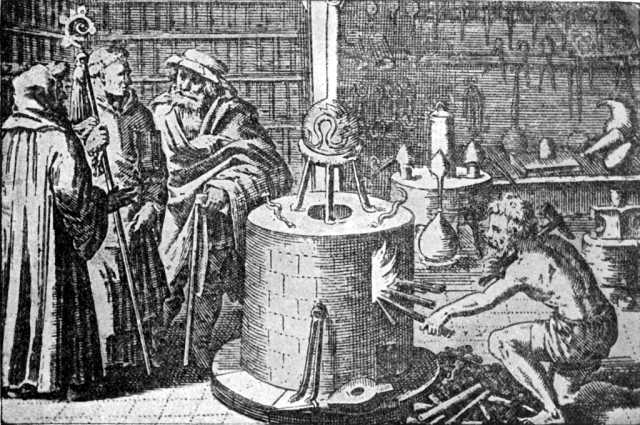In 1666, the renowned English mathematician, astronomer and natural philosopher, Sir Isaac Newton, observed a light ray entering a prism, and from this experience he made a brilliant discovery about light and colour; that white light is made up of a spectrum of several colours. Newton was fascinated with light, and believed that it had a close relationship to the concept that the early modern scientist knew as ‘the vegetable spirit.’
Newton was constantly awed by the beauty and complexity of the nature that surrounded him. Over time, he concluded that the massive variety of life and processes that occur in nature, such as growth, decay and fermentation, meant there must be some driving force that makes it all happen. He believed that the ‘vegetable spirit’ was that force, and thought it might also be linked with light.
To those only familiar with Newton’s discoveries in mathematics and physics, the idea of the ‘vegetable spirit’ might seem quite strange, and even pseudo-scientific. On the other hand, this idea and several others of the famous scientist were closely associated with a subject that he is not very often known for studying, and yet spent a great amount of his time devoted to: alchemy. In his lifetime, Newton wrote around one million words on alchemy, which shows how committed he was to the practice. Through his research into alchemy, Newton hoped to uncover the secret of the ‘vegetable spirit’, or the spirit of life.

Isaac Newton was well known for his studies in Optics, but he was also fascinated with the occult
Alchemy in Ancient Greece, Egypt and Rome
Even to Newton in the 17th century, alchemy was an archaic art with hundreds of texts available for him to study. But Newton was not the first to turn to alchemy in order to find what he was looking for, and was in fact one of the last in a long line of alchemists who sought to use the art for the purpose of discovering remarkable secrets.
The primary mission of ancient and Medieval alchemists was finding the way to create gold and the elixir of life. Unfortunately for them and Newton, alchemy has been shrouded in secrets and mystery throughout its existence, particularly during the Medieval period. Alchemists have repeatedly defended this secrecy, stating that its purpose is to keep the spectacular knowledge hidden from unworthy individuals who might use it for nefarious gains (though today we might suspect that the true reason for the secrecy is that, from the very beginning, the goals of the alchemists were impossible to achieve).
The origins of alchemy can be traced back 2,000 years before Newton to the Ancient Egyptians and Greeks. In fact, the word ‘alchemy’ may be derived from Khem, which was an Ancient Greek term for the land of Egypt. Even though alchemical tradition often states that the founding father of the practice was Hermes Trismegistus, it is very difficult to tie the root of alchemy to any one person. On the other hand, it is much more likely that the first proto-alchemists were Egyptian metalworkers, who would have worked with several different types of metal. It was gold that had the most value, therefore many focused their attention on this precious metal.
Over time, the experience of working with gold, silver and other metals led the most talented craftsmen to develop impressive alloys. Eventually, many different types of ‘gold’ entered the market, with major economic consequences as the manipulated metals and alloys were not in fact gold, but convincing fakes. By the time the Romans controlled Egypt, counterfeit gold had become such a problem that the Roman Emperor Diocletian (reigning between 284-305) ordered for the destruction of every single text that covered the making of gold or other metalwork.
The Greeks also played an important role in the early development of alchemy. However, these men were philosophers who were more often than not thinkers rather than doers, so their contribution was primarily focused on theories involving the nature of substances. The first alchemical documents were papyri written in Greek, often including processes and recipes in the creation of gold-like metals and alloys.
The teachings of Aristotle from the 4th century BCE made a profound impact on alchemical thought, as well as other Greek writers both before and after him. Yet it was not until Zosimos of Panopolis, who thrived c.300, that numerous alchemical texts began to emerge, which differed from the earlier papyri. In the writings of Zosimos, the practice of alchemy became less straightforward and more vague. For instance, he began to speak in riddles and used phrases whose meaning is difficult to determine. Zosimos may have been one of the first alchemists to conceal his ideas through secrecy and symbolism, but he started a tradition that later became central to the alchemical world.
Alchemy in the Islamic Golden Age
After the fall of the Western Roman Empire in the 5th century, the Islamic conquests made the Arabic civilisation one of the chief powers of the world. In this golden age of Islamic culture, Arabic scholars worked diligently to translate earlier Greco-Roman texts and assimilate as much of their ancient knowledge as possible. Especially after Egypt fell under Arabic control, documents that covered alchemy were also discovered and incorporated into the works of the early Islamic scholars. It is often thought that the term ‘alchemy’ was actually created in this period, because it combined the word Khem with the Arabic definite article al-, such as in the words alcohol and algebra. Furthermore, the key to immortality – which was just as important to alchemists as gold creation – is known as the elixir of life, from the Arabic word ‘al-iksir’.
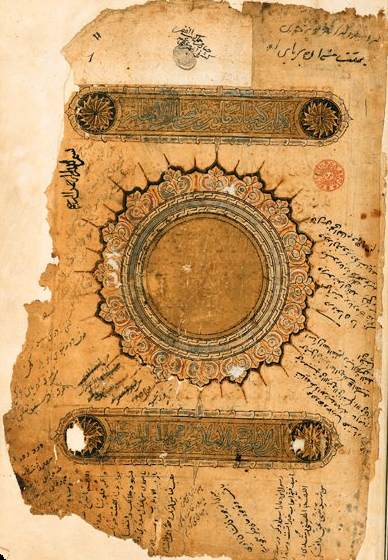
“The Alchemy of Happiness”, a Persian text by Al-Ghazali
The most prominent Arabic alchemist was Jábir ibn Háyyan, or Geber to western Europeans, of c.760. From the writings of Aristotle, Geber theorised that metals were created from a combination of mercury and sulphur, which became a fundamental aspect of alchemy. After Geber, the physician and philosopher Abu Bakr Muhammad ibn Zakariyya Al-Razi (or Rasis) dealt with alchemy during the 9th century, followed by Abu Ali ibn Sina (or Avicenna) in the 10th century. Once the works of these men and other Arabic scholars reached the Latin west, interest in alchemy was reignited throughout Medieval Europe.
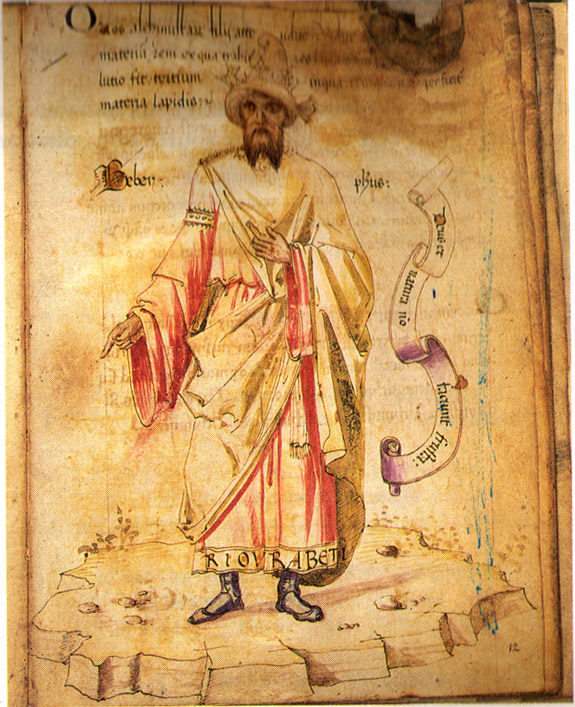
‘Geber’, or Jabir-ibn-Hayyan as seen in a Western depiction
Alchemy in Medieval Europe
Albertus Magnus, a Dominican from Swabia, was the primary scholar responsible for reintroducing alchemy to Europe in the 13th century. Albertus supported the mercury-sulphur theory of Geber, and although he believed that transmutation (the changing of matter into another form) was possible, he admitted it was very difficult to do. In 1244-5, Thomas Aquinas became the pupil of Albertus, and the master taught him what he knew, including his knowledge of alchemy. The other major alchemist of the 13th century, Roger Bacon, wrote about two different kinds: practical and theoretical. Bacon praised the first type for he truly believed that, if done right, the processes could improve metals and make them better than the state in which they are found in nature.
Albertus, Bacon and the other prominent alchemists of the era all believed that transmutation could be achieved, especially with metals. However, none of them could prove it. It was during this time that the philosopher’s stone began to increasingly appear within alchemical texts. Since transmutation was possible according to the alchemists, many began to believe that they simply lacked one vital ingredient to make the process work, which was the stone. And as the idea of the stone became more popular, so too did the alchemical texts become increasingly more difficult to interpret, as riddles, symbolism and coded language became more and more prevalent.
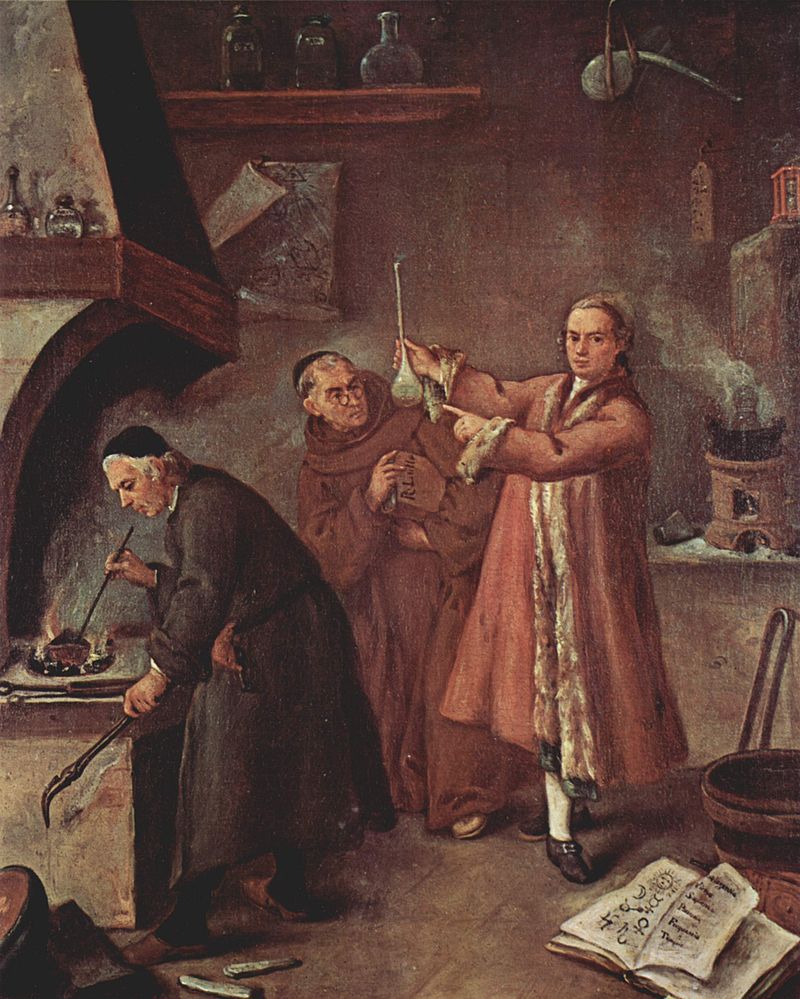
Alchemists distilling ingredients to find the philosopher’s stone
It is basically impossible to know exactly what the philosopher’s stone was, or would have been, because there have been so many different theories written about the substance. Some alchemists believed that the stone was comprised of the old common alchemical ingredients of mercury and sulphur, along with the new addition of salt, but with one major twist; these components were not just simply mercury, sulphur and salt, but rather special substances in a pure state with magical qualities, commonly referred to as the ‘essences’ of mercury, sulphur and salt.
There were other theories about the makeup of the stone, too. Similar to Newton’s idea of the ‘vegetable spirit’, some alchemists thought of the philosopher’s stone as the seed of gold that could be obtained from the metal. To the Medieval mind, metals were similar to vegetation, in that they both grew in the earth. Therefore, metals had seeds and the most precious seed of all was that of gold.
Regardless of the increasing secrecy surrounding alchemy, hundreds of alchemists from many different backgrounds were desperate to find or manufacture whatever was necessary in order to obtain the philosopher’s stone. Since the incredible substance could be used to serve the purpose of creating gold and the elixir of life, some alchemists sought enormous wealth, some desired fame, and others wanted the key to never-ending life, while there were some who had the grand aspirations of flooding the market with so much gold that the economic system would collapse and the world would be turned upside down. There were those who did gain fame or notoriety for their alchemical exploits, yet all of the other dreams were never fulfilled. In the end, the failures of others did not stop the alchemists, especially at a time when the supposed success stories achieved a legendary status that carried a lot more weight than the numerous average practitioners who simply faded into obscurity over time after years without success.
The Medieval alchemists who still focused on the quest either attempted to interpret the substantial corpus of texts, or conducted their own experiments in a laboratory. The heating of metals and other substances was a fundamental part of their work; therefore, the furnace was the core to the alchemist’s laboratory. This work area was also filled with many different types of utensils, tools and other equipment, such as beakers, crucibles, flasks, phials, jars, pestles and mortars, ladles, strainers and filters. As the alchemists worked hard in order to achieve their impossible goals, they constantly made improvements to the various apparatus that they used. Centuries later, much of this same equipment was incredibly important to the first chemists, and could often be found in their laboratories as well.
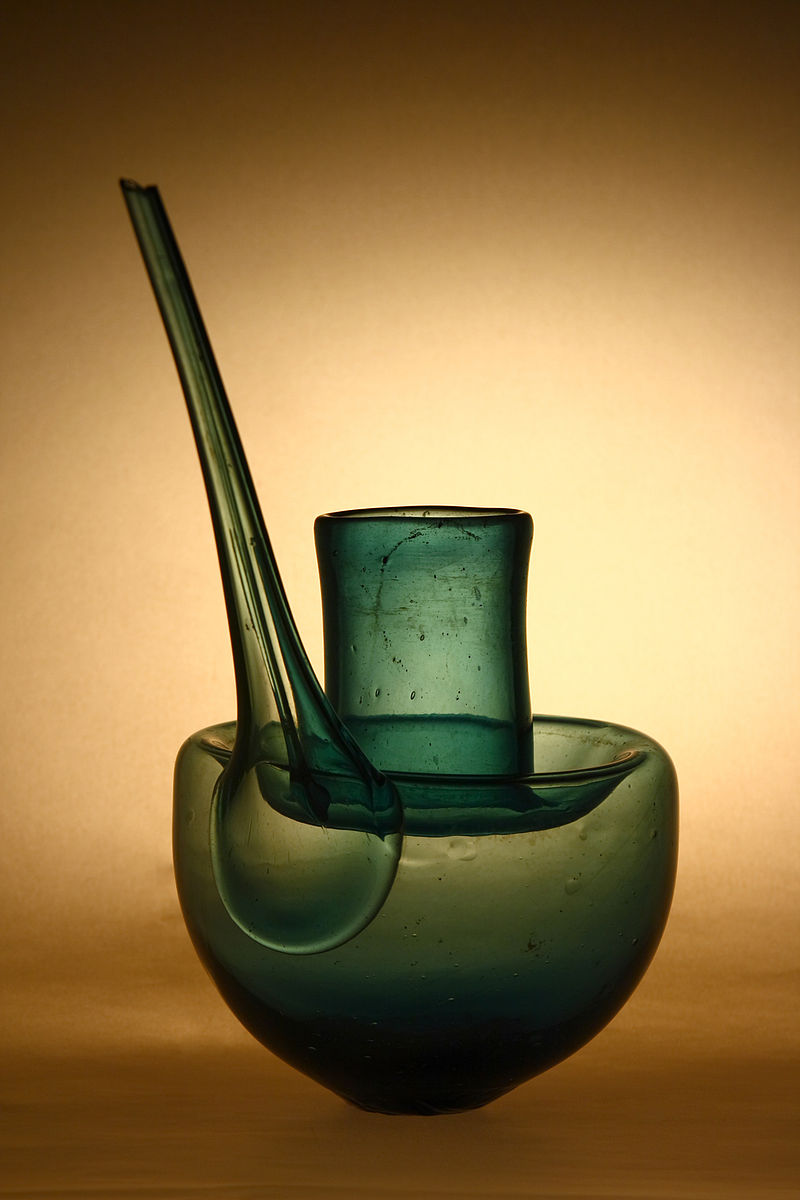
A Persian alembic from the 13th century, which was used to distill chemicals
Alchemy remained very popular and indeed respectable well into the Renaissance, with many other important individuals emerging on the scene, including Arnald of Villanova and Ramon Llull in the 13th century, George Ripley and Thomas Norton in the 15th century, and then Thomas Charnock in the 16th century, to name just a few. However, during the beginning of the early modern era, the art gradually began to lose its prestige.
Advancements in metallurgy that led to the discovery of the true nature of metals was one of the first causes, followed by many other scientific breakthroughs, which over time made so-called pseudo-sciences like alchemy and astrology obsolete. By the 17th century, Newton was at the forefront of this new scientific age, yet even a forward thinker such as him looked back upon and used the ancient knowledge of alchemy in order to uncover the secrets of life.
For more Medieval magic and weirdness, subscribe to All About History from as little as £13.
